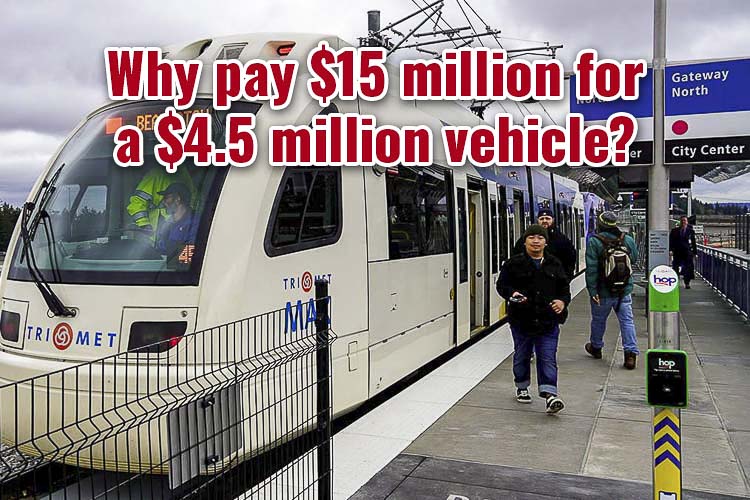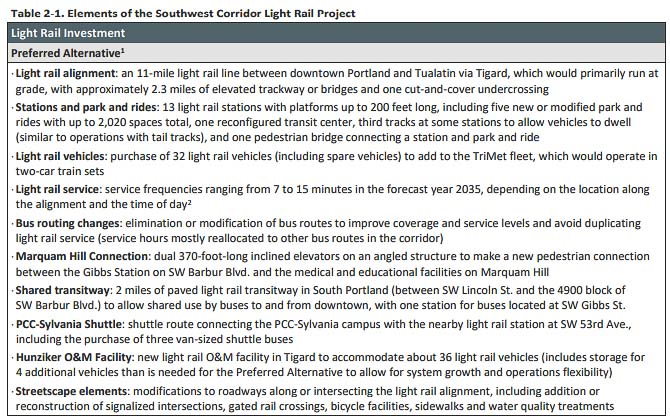John Ley
for Clark County Today
TriMet recently revealed a 52 percent cost variance on the price of 19 light rail vehicles the agency is demanding the Interstate Bridge Replacement Program (IBR) purchase for a three-mile extension of its MAX Yellow Line into Vancouver. Based on its 2023 financial plan, the cost of the 19 vehicles will range between $190 and $290 million, TriMet spokesman Tyler Graf told Clark County Today.
“It’s important to note that the new light rail vehicles will be needed for the new service provided along the extension of the MAX Yellow Line north and to the new stations identified in the plan,” Graf said.
At $190 million, the cost is $10 million per vehicle. At $290 million, the cost is $15.2 million per vehicle – a large variance.

TriMet’s “A Better Red” project cost $215 million, which includes four new light rail transit (LRT) vehicles to handle increased Red Line service to Hillsboro (Oregon). The price per vehicle is $4.5 million, according to Graf.
Why do light rail train cars cost $4.5 million each for the Better Red project, but between double and triple that amount when submitted to the IBR? Additionally, why were only four new vehicles needed for a 10-mile extension of the Red Line, but 19 are needed for a 3-mile Yellow Line extension?
The TriMet shell game
Critics suggest that it appears TriMet is playing a shell game, shuffling projects and orders for replacing LRT vehicles that are at the end of their useful life by getting someone else to pay.
In 2012, Siemens announced a $73 million TriMet order for 18 new generation S70 LRT vehicles. The price per vehicle was $4.055 million. The first train cars were to be delivered by August 2014.
TriMet planned to purchase 32 LRT vehicles for its Southwest Corridor MAX project, an 11-mile new line. It included 13 new stations at a proposed cost of $2.9 billion. The Southwest Corridor project was rejected by voters in November 2020.
Wikipedia reports an additional order was announced in 2018. “The initial order, finalized in July 2019, was for 26 cars, but the contract includes options for additional cars, for service expansion and the proposed Southwest Corridor MAX line, if built.” The order was reportedly increased to 30 vehicles in June 2021.
In October 2023 it was reported TriMet had ordered 30 new light rail vehicles. “We’re bringing on 26 of them to replace our aging first-generation trains, which are gradually being retired,” TriMet’s website says. “Four additional trains are being purchased for our A Better Red MAX Extension and Reliability Project, for a total of 30 new MAX trains on our rail system beginning in early 2024.”
TriMet currently has 145 light rail vehicles. Their oldest Type 1 vehicles (26) arrived around 1986 and are approaching 40 years of service. An additional 52 Type 2 vehicles began arriving in 1997. Roughly half TriMet’s LRT fleet is at or very near the end of their useful life.
It would appear TriMet is seeking to get the IBR to pay for 19 of the recently delivered new vehicles and/or future replacement vehicles. That begs the question: Will the IBR be paying for LRT vehicles for use in other parts of the TriMet system that have nothing to do with the Interstate Bridge project?

The IBR appears to be accepting the pricing and the number of vehicles TriMet is demanding, without doing any due diligence. The shell game works as long as nobody asks questions nor digs too deep. The transit agency expects to burn through nearly $1.1 billion in cash reserves over the next decade.
But paying $15 million for a $4.5 million MAX vehicle could seem excessive to even the most casual observer, who might ask where is the federal oversight? Where are the Washington legislators who are being asked to pay for one quarter of the cost? This assumes the federal government kicks in half, and Oregon pays the other one quarter of the cost.
Southwest Washington taxpayers have already expressed concerns about light rail coming into Clark County. Paying an excessive price, as well as purchasing an elevated (or unnecessary) number of vehicles, will seemingly only add to their desire to say “No Light Rail” and “No Tolls!”
Also read:
- POLL: Should the I-5 Bridge project be paused over cost and bidding concerns?Clark County Today’s weekly poll asks whether the I-5 Bridge replacement should be paused as questions grow around rising costs and a lack of competitive bids.
- Opinion: TriMet contract: MAX vehicles cost $4.5 millionRep. John Ley examines TriMet’s MAX vehicle purchases, arguing most were replacements and not connected to the bridge project.
- Expect delays on I-5 near Woodland for bridge inspection, May 18WSDOT will close a lane of southbound I-5 near Woodland on May 18 for a safety inspection.
- Opinion: ‘I’m more than just a little skeptical that IBR officials are doing everything they can to limit the cost of this project’Ken Vance shares his concerns over rising costs and limited contractor interest in the Interstate Bridge Replacement Program.
- Letter: ‘IBR has relied on this video to instill fear in the public and government officials to promote the construction of a new bridge’Bob Ortblad questions IBR’s use of a seismic video and urges a shift toward tunnel alternatives in this critical letter to the editor.










Light rail is vastly more expensive transit than the CTRAN bus and van transit system in place today. Looks like TriMet is covering costs for the whole system via bloated costs put on the IBR, to be paid in part with tolls on the I-5 and I-205 bridges. Plus TRI-MET plans to levy new taxes on Clark County to pay for the operations and maintenance costs of light rail. There is no federal requirement that light rail be used, it seems to be pushed by those who will gain lucrative contracts if costly light rail is forced on Clark County.
SW WA voters have rejected the OR TriMet MAX light rail extension into Clark County at the ballot box multiple times, but the Vancouver Mayor and other elected officials simply ignore those votes and push on, full steam ahead. The volume of commuters on transit is so low, there is no need for light rail at all, buses and vans can manage the small volume, only about 1% of commuters choose transit. Violent crimes and drug use in the trains, and on the station platforms are a growing concern.
All public transit is government boondoggle…PERIOD! Name one public transit operation…anywhere…that is profitable
https://www.bloomberg.com/news/articles/2015-06-08/one-chart-showing-how-much-money-major-u-s-public-transportation-systems-lose-per-trip
Older article, but pretty sure nothing has improved, only gotten worse.
Whenever government, at any level, gets involved in spending taxpayer money, we should all be ready for scandal…it never fails.
It’s especially true when there are vast amounts of taxpayer dollars at risk, like the IBR.
Suspicions are raised, especially regarding the IBR, because it is completely illogical to replace a 3 lane bridge with another 3 lane bridge.
Politicians always have an urgent need for contributions to their re-election campaigns…it is that Spector of dishonesty which rears its ugly head whenever illogical decisions are made involving billions of taxpayer dollars making no sense to the folks who pay the freight.
Is it any wonder large numbers of citizens don’t have any faith in government.
Here’s the reality: they’re using our money to buy THEM additional cars that will never see the loot rail bridge and will, instead be used everywhere else.
This whole thing is a scam to get us to subsidize their insanity.
This underscores the reality that rail transit projects have heavy on-going costs. Rail transit cars cost several times the cost of busses and are very inefficient when operating in non-peak times. Of course, trains are out of luck if there’s a problem on the tracks, while busses can simply use a different lane or route. Trains are very popular with the contractors, unions, and others that benefit from the waste of our tax dollars to support them. Promises are made and never kept. (BART made a number of promises when it was first proposed back in the 1950s. As of today, not a single one of the promises was kept — The first failed promise was “a seat for everyone” (the original trains did not have overhead grab bars installed but were retrofitted within months of opening), the longest kept promise was “free parking” at suburban stations, but that promise was dumped about 15 years ago.) While I have not observed Tri-Met as carefully as BART, I’m sure that their promises are no better. This is typical of rail transit / light rail systems all around the country.
I must have missed the Vote where Vancouver Voters approved of Light Rail. It has been on the Ballot in some form (never direct) and voters have rejected it each time. Government isn’t listening of course they know what’s good for us. Just say no-AGAIN.